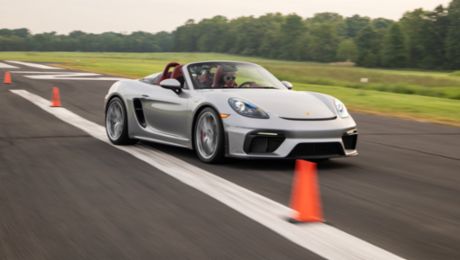718 Spyder: Fuel consumption combined 10.9 l/100 km; CO₂ emissions combined 249 g/km
718 Cayman GT4: Fuel consumption combined 10.9 l/100 km; CO₂ emissions combined 249 g/km
The high-revving, high-performance and efficient heart of the new Porsche 718 Cayman GT4 and 718 Spyder is a specially developed six-cylinder 4.0-litre boxer engine with lots of high-tech GT genes. The naturally aspirated engine is based on the same engine family as the turbocharged motors in the current 911 Carrera model series. With 309 kW (420 PS) and a linear power delivery, the most powerful and most emotive engine in the 718 model series captivates with its especially direct responsiveness and striking sound. It is happy to rev up to 8,000 rpm and reaches peak power at 7,600 rpm with 35 PS more than its 3.8-litre GT4 predecessor. The Spyder, which for the first time contains an identical engine, has 45 PS more than the last Spyder and, while it delivers maximum torque of 420 newton metres at between 5,000 and 6,800 rpm, its maximum engine speed is 200 rpm higher at 8,000 rpm.
This makes for thrilling performance. The new 718 Cayman GT4 reaches a top speed of 304 km/h, while the 718 Spyder can reach 301 km/h. They both outdo their predecessors significantly, by nine and 11 km/h respectively. They
both achieve the standard sprint from 0-100 km/h in 4.4 seconds. Their even more dynamic temperament and improved mid-range flexibility are particularly impressive: the 718 Spyder accelerates from 80 to 120 km/h in just 6.0 seconds in fifth gear. The 718 Cayman GT4 achieves an identical figure. The two mid-engined sports cars demonstrate their efficiency with a combined NEDC fuel consumption of 10.9 l/100 km.
High power output and torque values
The high-revving six-cylinder engine is based on intensively refined technologies for the 4.0-litre boxer engine. Mechanically, a stable base is formed by an extremely rigid high-strength forged-steel crankshaft, geometrically optimised connecting rods and a generously dimensioned crankshaft main bearing with a diameter of 67 mm. The robust plastic sump weighs 36.5 per cent less than the comparable cast part of the last model.
In view of the high engine speeds possible, rocker arms with hydraulic valve clearance compensation are responsible for operating the valves. The electronic engine management system adjusts the timing of the four VarioCam camshafts according to load requirement and engine speed, for example over an adjustment range of 30 crankshaft degrees on the outlet side. This ensures high power output and torque values across the entire engine speed range, thus improving drivability.
Direct fuel injection with piezo injectors
The mixture that forms in the combustion chambers meets special requirements. The centrally positioned injectors of the direct fuel injection (DFI) system are controlled by piezo elements for the first time in a high-speed engine. They open the injection valves by expanding upon application of a control voltage. When there is no current flowing, the crystals contract and the valve opening closes again. As a result, the fuel is finely atomised with a maximum fuel pressure of 200 bar, and combustion is even more precise. The even better spray pattern of the piezo injector reduces droplet formation on the cylinder walls and counteracts potential soot formation. The result? Fuel consumption and exhaust emissions fall, while the efficiency of the naturally aspirated engine increases.
The variable intake system supports rapid gas exchange in the combustion chambers. It features two resonance valves, which open individually or simultaneously depending on the power requirement and therefore adapt the frequency of the pulsating air column on its way to the valves, according to the engine speed. This improves the fill level in the cylinders and results in more impressive torque characteristics.
Sports exhaust system with gasoline particulate filters
On the outlet side, the new sports exhaust system satisfies several objectives at once thanks to its complex design: its gasoline particulate filters (GPF) play an important role in compliance with the Euro 6d-Temp emissions standard. Its large cross-section reduces exhaust backpressure and therefore increases power while the special arched design of the sports exhaust system provides the necessary clearance for an efficient rear diffuser (see the Body and Aerodynamics section below).
For this purpose, the two main silencers, which were still separate on the last GT4, have been combined to form a central component, which surrounds the diffuser in the shape of a saddle and makes the best possible use of the small amount of available space. Nevertheless, the volume of the silencer is sufficient to meet the strictest noise requirements. Thanks to the valve controller, the iconic boxer sound remains untouched: depending on the engine temperature and load requirements, it combines optimum power delivery with emotive acoustics, especially at high speeds.
Adaptive cylinder control
A special innovation to reduce exhaust emissions and fuel consumption is the adaptive cylinder control. At engine speeds of between 1,600 and 3,000 rpm and a load request of up to a maximum torque of 100 Nm, it temporarily interrupts the injection process of one of the two engine banks, and the six-cylinder engine temporarily operates in three-cylinder mode. At constant load, the cylinder bank is changed every 20 seconds to ensure a uniform load and flow through the catalytic converters. With the exception of a slightly different sound profile, this switching back and forth goes unnoticed by the driver. The effect, however, is palpable: the adaptive cylinder control can reduce the CO₂ emissions by around 11 grams per kilometre. It can be deactivated together with the start/stop function, which is featured for the first time in the 718 Cayman GT4 and 718 Spyder.
Six-speed manual gearbox as standard
The power of the six-cylinder naturally aspirated engine is passed on to the rear wheels by a six-speed manual gearbox with a dual mass flywheel. With its shortened gear lever, it emphasises the emotive driving experience. Dynamic transmission mounts minimise the transmission of oscillations and vibrations from the drivetrain to the body, as well as reducing mass movements of the drive unit when driving in a spirited manner. Add to this the dynamic double-clutch function: it reduces wear and improves vehicle stability when shifting down gears. This function can be activated by pressing the AUTO BLIP button on the centre console. The dual mass flywheel has been carried across from the 911 GT3.
Exhaust quality
Centrally positioned piezo injectors for the high-pressure direct fuel injection, adaptive cylinder control, start/stop function: the exhaust quality of the new high-speed naturally aspirated engine in the Porsche 718 Cayman GT4 and 718 Spyder is the result of complex technology. The gasoline particulate filters (GPF) in the sports exhaust system make the biggest difference. They benefit from a broadband lambda control unit with one lambda sensor, which controls the composition of the exhaust gas separately for each side and for each cylinder bank. Further sensors monitor the conversion of pollutants in each of the catalytic converters. The necessary regeneration of the GPF happens automatically and without the driver noticing.




